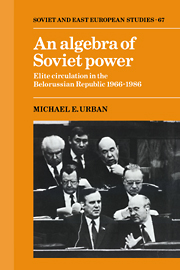Book contents
- Frontmatter
- Contents
- List of figures and tables
- Preface
- Acknowledgements
- 1 Method, model and historical background
- 2 Hierarchy, mobility and a stratified model
- 3 Centralization as a determinant of elite circulation
- 4 The regional structure of elite circulation
- 5 The structure of patronage affiliations
- 6 Does faction make a difference?
- 7 Political succession
- 8 Conclusions, implications and the question of levels
- Appendix A Stratification of positions in the Belorussian Republic, 1966–86
- Appendix B A roster of factional groups in the Belorussian Republic, 1966–86
- Notes
- Index
- Soviet and East European Studies
5 - The structure of patronage affiliations
Published online by Cambridge University Press: 09 November 2009
- Frontmatter
- Contents
- List of figures and tables
- Preface
- Acknowledgements
- 1 Method, model and historical background
- 2 Hierarchy, mobility and a stratified model
- 3 Centralization as a determinant of elite circulation
- 4 The regional structure of elite circulation
- 5 The structure of patronage affiliations
- 6 Does faction make a difference?
- 7 Political succession
- 8 Conclusions, implications and the question of levels
- Appendix A Stratification of positions in the Belorussian Republic, 1966–86
- Appendix B A roster of factional groups in the Belorussian Republic, 1966–86
- Notes
- Index
- Soviet and East European Studies
Summary
Following the implications of the analysis conducted in the preceding chapter, we turn our attention here to tracing out the patronage ties that appear to bind the actors together into identifiable factions in mutual competition for political office within the BSSR. We take up, first, the matter of personnel flows within and among the several organizations - party, soviet, ministerial and so forth - that collectively comprise the formal framework of all offices in our sample. This exercise completes our study of those factors that make up the general anatomy of the personnel system in Belorussia - hierarchy, region and organization. The results of our investigations on this level enable us, in turn, to frame the more specific and concrete analysis of factional affiliation that follows. Secondly, a methodological orientation toward the question of identifying patron-client ties is developed, yielding two techniques for classifying members into patronage groups. These techniques are then applied to the data.
Mobility within and across organizations
The movement of personnel, when viewed in the light of its organizational dimension, is often regarded as at least a rough measure of elite integration in the USSR. This way of looking at things sees the tendency in the Soviet system that works in the direction of fragmenting the elite on the basis of numerous, organizationally based, interest groupings - what Jerry Hough has referred to as ‘bureaucratic pluralism’ - as counteracted by the rotation of officials through a variety of organizations such that psychological attachments to any single one of them are unlikely to form, since extended interaction among the members of a given organization is regularly disrupted.
- Type
- Chapter
- Information
- An Algebra of Soviet PowerElite Circulation in the Belorussian Republic 1966–86, pp. 79 - 97Publisher: Cambridge University PressPrint publication year: 1989



